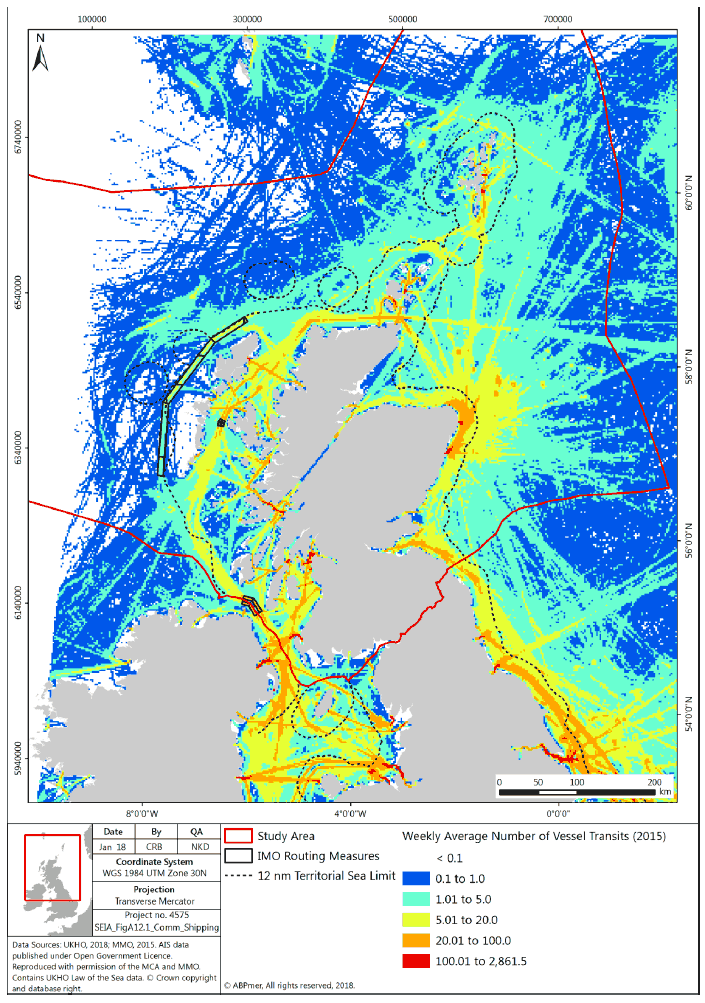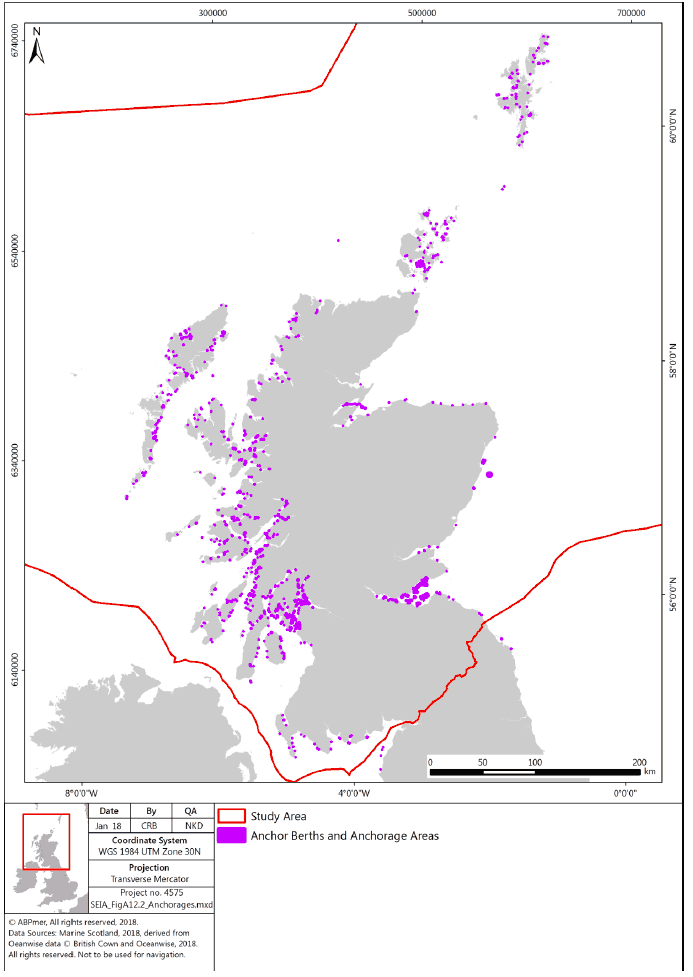Sectoral marine plan for offshore wind energy: social and economic impact assessment scoping report
Sets out the methodology and scenarios for scoping and undertaking a socio-economic impact assessment.
A.13. Commercial Shipping
A.13.1 Sector Definition
This sector relates to the transport of freight and passengers both within Scottish waters and internationally. Shipping routes can be split into two distinct types; transiting vessels passing through Scottish Waters and vessels with either their origin or destination port within Scotland. This section also considered anchorages.
A.13.2 Overview of Activity
AIS density grid data ( Figure A.13.1) indicates that, in general, vessels move up the west coast of Scotland through the North Channel (or Straits of Moyle), the Minches, and east-west between the northern coast of the mainland and Orkney, from where vessels access the North Sea. Some of the areas showing the highest intensity of vessel movement include ferry routes ( e.g. between Northern Ireland and Loch Ryan, between the outer Hebrides and the mainland via the Sound of Mull and between the Shetland Islands, Orkney and the Scottish mainland) and around the Clyde. There is also an area of particularly high intensity of vessel movements around Fraserburgh, Peterhead and Aberdeen, related to the offshore oil and gas sector. To minimise collision risk, some heavily used areas have Traffic Separation Schemes ( TSS) which divides opposing traffic into lanes (see Figure A.13.1). Anchorages are located all around the Scottish coastline in inshore waters ( Figure A.13.2) but are located in highest densities along the west coast, Orkney, the Moray Firth and the Firth of Forth.
In 2013, shipping contributed an estimated £200 million GVA (17% of the UK total) and it was estimated 11,200 of the UK nationals employed in the shipping industry (31% of the UK total) were based in Scotland (Oxford Economics, 2015).
With regard to future trends, shipping volumes bear a direct relationship to the global economic market. As markets react to the changing financial situation, shipping lines respond with services to move goods and people. The most notable variable to affect the volume and intensity of shipping into the future will be the technology and innovations used to design future shipping. Ship design seeks for bigger, faster and more economic transhipment of goods and people ( ABPmer and RPA, 2013).
Figure A.13.1 shows an overview of commercial shipping activity in Scotland. Information sources that can be used in the assessment are listed in Table A.13.1.
Figure A.13.1 Commercial shipping activity in Scotland

Figure A.13.2 Anchorages

Table A.13.1 Information sources for the commercial shipping sector
| Data Available | Information Source |
|---|---|
| UK port and shipping statistics ( UK) | Department for Transport |
| AIS data | Maritime and Coastguard Agency ( MCA) released under open Government licence by the Marine Management Organisation |
| Admiralty charted formal anchorages | Admiralty charts |
| Economic value of shipping ( UK/Scotland) | Oxford Economics, 2015 |
A.13.3 Potential Interactions with Offshore Wind
Table A.13.2 shows potential interaction pathways between commercial shipping and offshore wind arrays and export cables. Based on the approach to scoping described in Section 2 in the main report, the table also records whether the interaction:
- Is not likely to result in a significant socio-economic impact on the sector; or
- Is likely to result in a significant socio-economic impact on the sector and hence will require a detailed assessment;
The rationale underlying this expert judgement is provided in the table. Where it is not currently possible to make a judgement regarding the likelihood of a significant socio-economic impact due to insufficient information (for example, in relation to the extent of overlap between a sector activity and the DPO Areas) the table indicates that scoping will be required to be undertaken once sufficient information becomes available. Furthermore, as described in the main report, there is currently no information regarding the likely location of export cable routes/corridors and as such, it is not possible to undertake a meaningful assessment of the potential for any sector activity/export cable interaction to give rise to significant socio-economic effects. Rather, the potential for any interaction will be identified in Regional Locational Guidance.
Table A.13.2 Potential interaction pathways
| Potential Interaction |
Technology Aspect and Phase |
Potential Socio-economic Consequences |
Initial Scoping Assessment |
|---|---|---|---|
| Obstruction of transiting vessel and/or ferry routes; increased steaming distances and time. |
Arrays (construction and operation) |
Increased costs, effect on regular route (ferry) competitiveness, potential for increased insurance costs. |
Any significant impacts would be expected where DPO areas overlap with commercial shipping or ferry routes. The location of the DPO areas is not currently available, however, given the high intensity of vessel transit routes in some areas, and the critical importance of ferry routes, it has been assumed that avoidance of significant impacts may not be achieved through spatial planning alone and that the impact of this interaction will need to be assessed once the location of the DPO areas is available. See Section A.13.5.1 for proposed assessment methodology. |
| Export cables (construction only) |
Increased costs |
Any significant impacts would be expected where export cable corridors intersect commercial shipping or ferry routes. Export cable routes are uncertain. Constraints inshore of DPOs will be identified in the RLG. However, it can be noted that any potential impact will only occur during the construction phase (export cable laying) and hence will be temporary. No detailed assessment possible. |
|
| Displacement of formal (commercial) anchorage areas |
Arrays (construction and operation) |
Increased costs through increased steaming distance from the port to the relocated anchorage, plus the associated cost with lifting and laying ship mooring buoys (should these be part of the displaced anchorage). |
Any significant impacts would be expected where DPO areas overlap with formal (commercial) anchorages. The location of DPO areas is not currently available. However, as the DPO areas will be located offshore, it is not considered likely that significant overlaps between anchorages and DPO areas will occur. Where any overlap does occur, it is considered that there is scope to avoid any significant impact through marine spatial planning. No detailed assessment required. |
| Export cables (construction and operation) |
Increased costs through increased steaming distance from the port to the relocated anchorage, plus the associated cost with lifting and laying ship mooring buoys (should these be part of the displaced anchorage). |
Any significant impacts would be expected where export cables corridors intersect with formal (commercial) anchorages. Export cable routes are uncertain. Constraints inshore of DPOs will be identified in the RLG. No detailed assessment possible. |
|
| Increased marine risk |
Arrays (construction and operation) |
Increased marine risk ( e.g. risk of collision between vessels or vessels and infrastructure) relating to radar interference from offshore wind installations, with implications for costs to sector |
Radar mitigation will be required as a condition of consent if there is a potentially significant effect. This cost will be borne by the developer. No detailed assessment required. |
| Export cables (construction) |
Temporary increased marine risk ( e.g. risk of collision between vessels) along cable corridors whilst cabling is being laid, with implications for costs to sector |
Developers are responsible for ensuring appropriate Navigational Risk Assessments are provided for their marine works. No detailed assessment required. |
A.13.4 Scoping Methodology
A.13.4.1 Impacts to shipping/ferry routes
To determine where detailed assessments of the interaction may be required when DPO area locations are available, the following scoping criteria are proposed:
- Where DPO areas are transected by commercial navigation route(s) or ferry routes, the density of traffic should be assessed. If the average density of traffic is 5 or more vessel movements per day, a detailed assessment should be undertaken;
- If the DPO area is transacted by an IMO recognised "ship routeing system", a detailed assessment should be undertaken;
- However, if the spatial extent of indicative arrays is predicted to occupy less than 5% of the DPO area it has been assumed that spatial planning within the DPO area can be used to avoid significant impacts and no detailed assessment should be required.
A.13.5 Assessment Methodology
A.13.5.1 Impacts to shipping/ferry routes
Where scoping indicates that a detailed impact assessment is required, the cost of displacement of commercial shipping/ferry routes can be assessed based on the number of vessels potentially displaced (based on AIS data), the estimated potential extra steaming distance and time and average fuel and labour costs for commercial vessels.
A.13.6 Data Limitations
AIS A transmission is mandatory for commercial vessels above 300 GT and all passenger ships regardless of size. As a result, some vessel classifications are underrepresented in the AIS data, including: commercial vessels below 300 GT; recreational vessels (see Appendix A.12), fishing vessels (See Appendix A.7) and naval vessels on deployment (see Appendix A.8). AIS B is optional and may be carried by smaller vessels including recreational, fishing and smaller commercial craft.
AIS data collected by the Maritime and Coastguard Agency is monitored from terrestrial receiver stations. Reception range is therefore limited to line of sight and dependent on the power of the transmitting vessel (hence, larger vessels with transmitters mounted higher up are more likely to be received than smaller vessels). Therefore, AIS coverage is more defined closer to shore, and underestimated for vessel activity outside of the reception range ( i.e. further offshore).
Contact
There is a problem
Thanks for your feedback